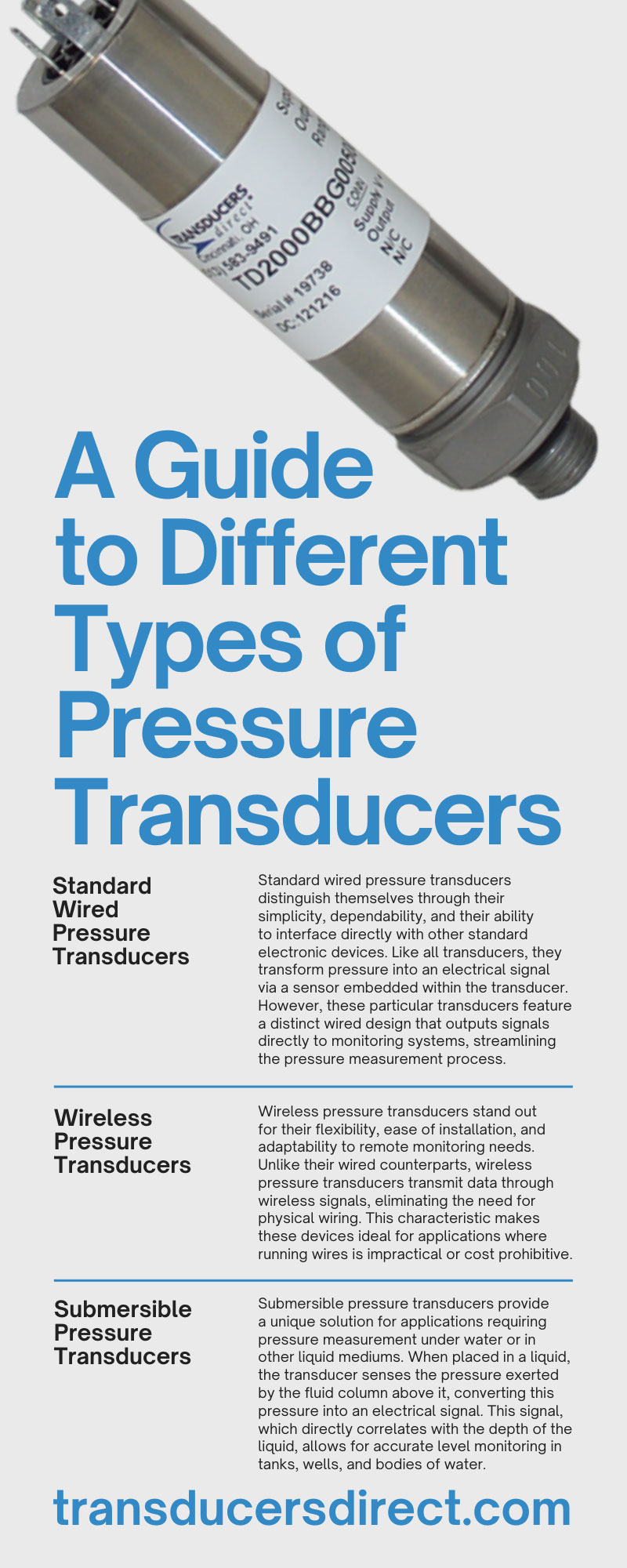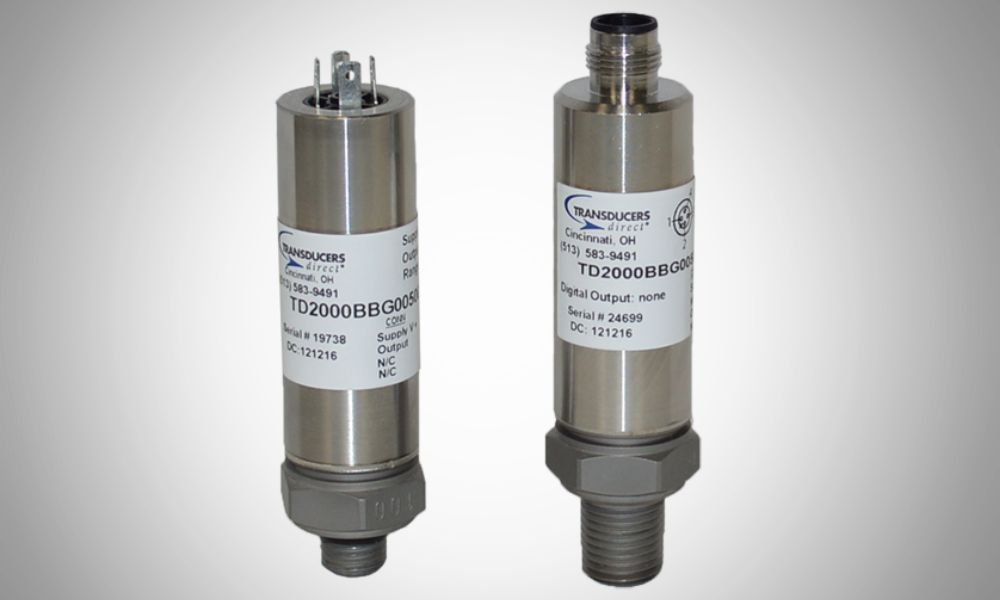A Guide to Different Types of Pressure Transducers

In any industrial setting, the selection of appropriate tools and devices significantly impacts the safety and efficiency of operations. One such crucial device is the pressure transducer; its role in monitoring and controlling processes cannot be overstated. Pressure transducers are integral to a wide range of applications across numerous industries.
These devices translate pressure measurements into usable data, ensuring operations run smoothly and safely. Understanding more about pressure transducers and their specific uses can help you decide which is most suitable for your application. This guide to different types of pressure transducers will take a closer look at these versatile tools and how they contribute to an efficient and secure working environment.
What Are Pressure Transducers?
Pressure transducers are essential devices in many industrial applications. They convert pressure into an electrical signal, allowing for accurate and reliable measurements. The operation of a pressure transducer begins when pressure is applied to a sensing element within the device. This element, typically a flexible diaphragm, moves in response to the pressure. The movement of this diaphragm then causes a corresponding change in electrical output, providing a measurable signal that correlates directly with the applied pressure.
Pressure transducers serve a wide range of applications across various industries. In the oil and gas industry, they monitor the pressure in pipelines to prevent leaks and ensure the efficient flow of materials. In healthcare, pressure transducers measure blood pressure and respiratory pressure. Understanding the role of pressure transducers in these contexts can help users select the most appropriate device for their specific needs.
Standard Wired Pressure Transducers
Standard wired pressure transducers distinguish themselves through their simplicity, dependability, and their ability to interface directly with other standard electronic devices. Like all transducers, they transform pressure into an electrical signal via a sensor embedded within the transducer. However, these particular transducers feature a distinct wired design that outputs signals directly to monitoring systems, streamlining the pressure measurement process.
In manufacturing settings, for instance, these transducers enable precise monitoring and control of system pressures, which is crucial for operating equipment such as hydraulic presses and injection molding machines. This is just one example of how the choice of a standard wired pressure transducer can be uniquely advantageous depending on the specific requirements of an application. It’s also worth noting that high-performance and low-cost pressure transducers can fall under the standard wired category.
Wireless Pressure Transducers
Wireless pressure transducers stand out for their flexibility, ease of installation, and adaptability to remote monitoring needs. Unlike their wired counterparts, wireless pressure transducers transmit data through wireless signals, eliminating the need for physical wiring. This characteristic makes these devices ideal for applications where running wires is impractical or cost prohibitive. The sensor within the wireless transducer undergoes deformation when exposed to pressure, similar to standard wired transducers. However, instead of transmitting a direct electrical signal, a wireless pressure transducer converts this change into a digital signal and sends it wirelessly to a receiving unit. This unique capability allows for real-time monitoring of pressure changes from a distance.
The versatility of wireless pressure transducers allows them to be used in a wide range of applications, particularly in industries requiring portable monitoring or where installation locations are challenging. For instance, in the HVAC industry, wireless pressure transducers enable technicians to monitor system pressures remotely, making diagnostics and maintenance more efficient. Similarly, in industrial environments with large or complex machinery, these transducers provide a solution for monitoring pressures in hard-to-reach areas without needing to run extensive wiring. In addition, the portability and ease of installation of wireless transducers make them an excellent choice for temporary setups or moving equipment. And as with standard wired pressure transducers, both high-performance and low-cost transducers can feature wireless technology.
High-Performance vs. Low-Cost Pressure Transducers
High-performance pressure transducers deliver exceptional accuracy, durability, and reliability, making them suitable for demanding applications that require precise measurements. These transducers often feature robust construction, high-quality materials, and sophisticated sensing technologies, enabling them to withstand harsh operating conditions and maintain accuracy over various pressures. They can deliver continuous, reliable data even under extreme temperatures, pressures, or corrosive environments. High-performance transducers may also offer advanced features, such as digital outputs, programmability, and onboard signal processing capabilities, which enhance their versatility and ease of integration into complex systems.
On the other hand, low-cost pressure transducers prioritize affordability while maintaining an acceptable level of performance. These transducers typically offer basic functionality and may not have the same level of precision, durability, or advanced features as their high-performance counterparts. However, these low-cost options are adequate for less demanding applications where extreme precision is not required and operating conditions are relatively benign. Low-cost transducers are often used in cost-sensitive applications or in situations where a large number of transducers are needed. While they may lack the robustness and feature set of high-performance models, low-cost transducers provide an economical solution for simple pressure monitoring tasks.
Submersible Pressure Transducers
Submersible pressure transducers provide a unique solution for applications requiring pressure measurement under water or in other liquid mediums. These devices, designed with special materials and seals, can withstand prolonged submersion without compromising their functionality or accuracy. When placed in a liquid, the transducer senses the pressure exerted by the fluid column above it, converting this pressure into an electrical signal. This signal, which directly correlates with the depth of the liquid, allows for accurate level monitoring in tanks, wells, and bodies of water. In industries such as wastewater management, oil and gas, and marine studies, submersible pressure transducers offer a reliable, robust solution for underwater pressure monitoring.
The type of pressure transducer you choose significantly impacts the efficiency and accuracy of your pressure monitoring tasks. Whether you require the precision and durability of high-performance transducers, the cost-effectiveness of low-cost models, the flexibility of wireless devices, or the unique capabilities of submersible units, there is a pressure transducer designed to meet your specific needs. Understanding these different types of pressure transducers empowers you to make informed decisions that can enhance your operations, improve safety, and drive innovation in your industry.
Transducers Direct offers a wide range of pressure transducers tailored to various applications and industries. Our team of experts is committed to helping you find the right solution for your business. With our extensive selection and industry expertise, you can trust us to provide the transducers that will help you optimize your pressure monitoring tasks.




Leave A Comment